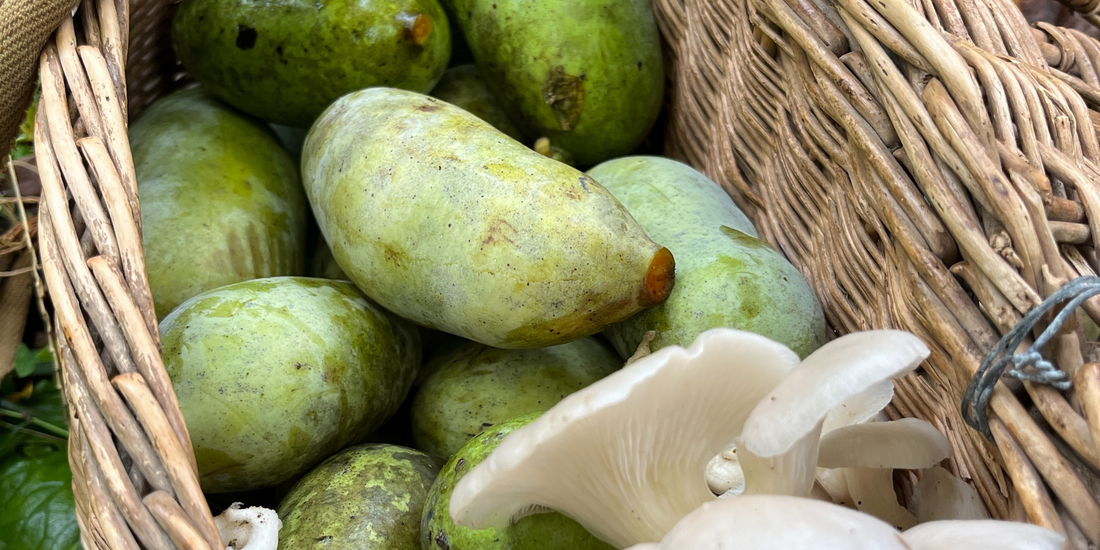
Pawpaw Foraging, Variability, & Tackling Bitterness
Share
Pawpaws (Asimina triloba) have been a hot topic for awhile now. They pop up on social media and inevitably get a ton of attention. And why wouldn’t they? Pawpaws are hefty, creamy, complex - an amalgamation of tropical flavors bursting forth from the lush fruit of a tree that seems out of place in its native range. Nature is filled with wild food, and yet most people aren’t moved so much by gangly little “weeds” (e.g. chickweed and cleavers) nor by the edible nuts, roots, shoots, etc. that might mean half a day’s work of processing. But a pawpaw - why, that is little effort with great reward. Once you find a pawpaw patch, which is probably the hardest part of the whole endeavor, you simply shake the trees or better yet, collect the fruit already ripening on the ground and revel in your haul.
The fruits are marvelously BIG compared to many other foragables in temperate North America. With little time and little effort you have pounds of food (related: optimal foraging theory). I’m sure there is some primal surge that still happens when we collect pawpaws. I’m hazily aware of my own pupils dilating as I approach a wild patch and smell the sweet tropical scent of nearly rotten pawpaws mixed with damp earth. Anxiety heightens when I come around the bend and see the undergrowth matted down, a sign that animals might have beaten me to it - or worse, other humans!

Wild harvesting pawpaws is excitingly fun hunter-gatherer role play, but I also like the idea of having my own patch here on the farm. Hunter seeded a huge area near the creek this year. The seeds he planted came from this year’s wild harvest, so the trees will have a lot of fruit variation. Unless a grafted cultivar is denoted, a pawpaw grown from seed can turn out to be quite different from its siblings. This is also true of the seed grown pawpaws we sell here online. And if you are reading this and wanting to purchase some, I’m sorry to say that we are sold out for the 2023 season. They sell out fast! We’re hoping to triple our inventory for 2024, so check back later or hit the ‘notify me when available’ button if you also want to #growyourown.

The straight species variability is interesting. The fruit pulp of one tree might be more yellow or orange or cream than another. One might have more notes of banana or mango. Some may strike you as more floral than others. And some have a strong vanilla note, which is my favorite. These factors are also influenced by the stages of ripeness. The levels of astringency and bitterness can also vary, which leads me to my next point…Despite all the wonderful attributes of wild pawpaws, I’ve had to toss out my fair share of pawpaw puree due to bitterness. Standing in the pawpaw patch I’ll go to town on a couple of pawpaws, and they’ll taste divine. But once I get home and do the tedious task of separating the seeds and skin from the pulp, I’m often left with a bitter tasting and discolored product. If you’ve also faced similar issues, here is what worked for me this summer:

- TASTE EACH PAWPAW: With so much variability in wild pawpaws, I’ve found it wise to taste test** each one before processing. If an off-tasting one gets in, it can ruin the whole batch.
- AVOID PULP NEAR SKIN/SEEDS: That bitter quality is concentrated around the skin and seeds. I’ve known that fact for awhile now and thought I’d been sufficiently avoiding those areas. I’ve even seen people scraping every last bit of pulp from around those areas, so I’d done the same. After all, waste not want not. But nope, that hasn’t worked for me. This summer I took a much more cautious approach. I cut each pawpaw in half, gently squeezed out the pulp with my hand like a tube of toothpaste, and tossed the skins and seeds without scraping what was still hanging on. It felt wrong to leave some pulp behind, but the end result was worth it. I still got roughly 5 cups of pulp, and it wasn’t ruined by bitterness!
- KEEP COLD & COVERED: Pawpaw pulp oxidizes quickly. It will discolor to an unappetizing shade of orange or brown, and I’ve found this to also contribute to that undesirable bitter aftertaste. Working in small batches seems to help. After quickly processing a couple of pawpaws, go ahead and put that pulp in the refrigerator and keep it tightly covered with cling film. It’s a lot of back and forth trips to the fridge but effective.
- USE QUICKLY OR FREEZE: Like an avocado, pawpaw pulp is best used immediately. Freezing will suspend deterioration but might change the texture a bit.
The wild pawpaws in your area may or may not be so finicky, but I hope these tips help if you do come across bitter ones. You can also look into growing cultivars, which have been specifically selected to have none of the bitter taste. We are working on offering such cultivars in the future.

:: Wander Here for PAWPAW RECIPES ::

SENSITIVITY WARNING: Pawpaws do not agree with everyone. As with every new food, it is best to try a small amount and see how you respond. Gastrointestinal sensitivity to pawpaw is not unheard of. Cooking pawpaw increases the risk of reaction. Exercise caution.



2 comments
Hi Carol, you are our very first commenter! Thanks so much for that! I haven’t seen a zebra swallowtail in quite some time. Hopefully we’ll see more with this new grove of pawpaws we’ve planted. Thanks for sharing that fact! I’ll check out your YT :)
Do you see Zebra Swallowtail butterflies in your gardens? Paw Paw is the host shrub/tree for them. They are my favorite butterflies that sometimes come to my garden. I just planted a Paw Paw tree/shrub in my garden this year. I’d like to have more to attract the Zebras. You might be able to see one in my garden at this link to a YouTube video. I’ll be ordering some plants. Nice selection. Thanks.
https://studio.youtube.com/video/EmlSZWJQfTg